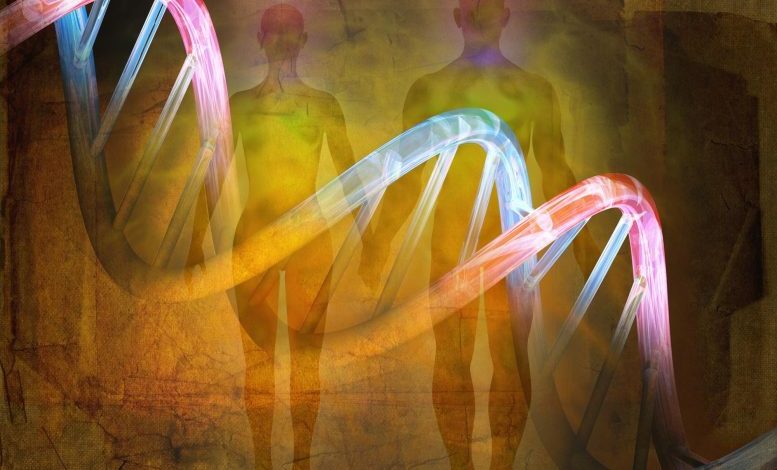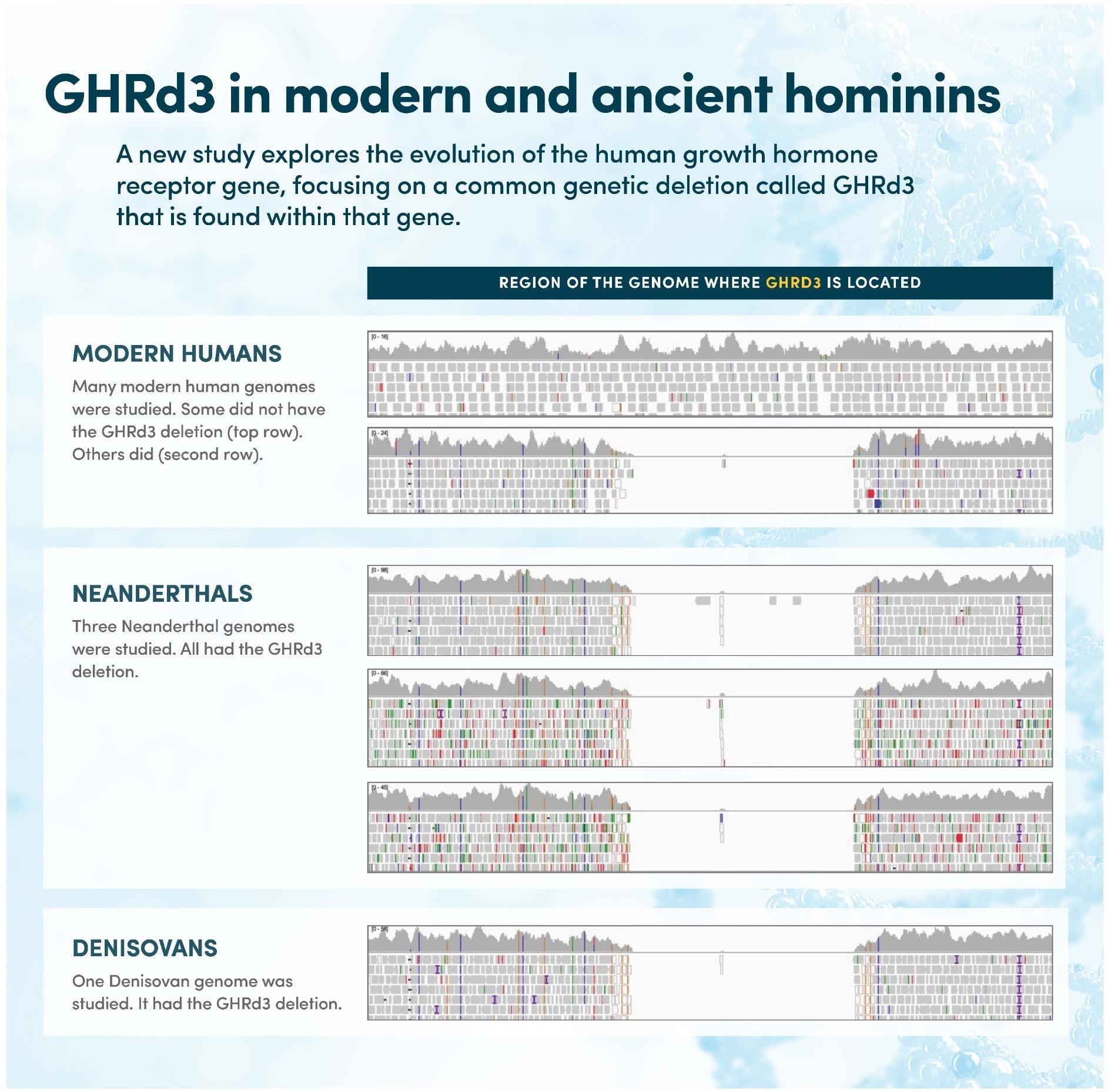
A paper in Science Advances focuses on the evolution of the human growth hormone receptor gene.
A new study delves into the evolution and function of the human growth hormone receptor gene, and asks what forces in humanity’s past may have driven changes to this vital piece of DNA.
The research shows, through multiple avenues, that a shortened version of the gene — a variant known as GHRd3 — may help people survive in situations where resources are scarce or unpredictable.
Findings were published on September 24, 2021, in Science Advances.
Here’s the story the study tells: GHRd3 emerged about 1-2 million years ago, and was likely the overwhelmingly predominant version of the gene in the ancestors of modern humans, as well as in Neanderthals and Denisovans.
Then, “In the last 50,000 years or so, this variant becomes less prevalent, and you have a massive decrease in the frequency of this variant among East Asian populations we studied, where we see the estimated allele frequency drop from 85% to 15% during the last 30,000 years,” says University at Buffalo evolutionary biologist Omer Gokcumen. “So the question becomes: Why? Was this variant favored in the past, and it fell out of evolutionary favor recently? Or is what we are observing just a blip among the complexity of genomes?”

The research provides new insights into the function of GHRd3 that may help explain why these evolutionary changes occurred, demonstrating that the variant may be useful in coping with nutritional stress.
“We think that this variant is beneficial where there are periods of starvation, which was the case for most of human evolution,” says Gokcumen, PhD, associate professor of biological sciences in the UB College of Arts and Sciences. With regard to GHRd3’s waning prominence in recent human history, he speculates that, “Maybe the rapid technological and cultural advances over the past 50,000 years have created a buffer against some of the fluctuations in resources that made GHRd3 so advantageous in the past.”
“GHRd3 is interesting because it is a very common deletion that is variable between you and me among humans,” says Marie Saitou, PhD, tenure-track investigator at the Norwegian University of Life Sciences and a former postdoctoral researcher in Gokcumen’s lab at UB. “Normally, these kinds of important fundamental genes do not change between human to human, and are highly conserved in other animals even.”
The work was led by Saitou; Skyler Resendez, PhD, a recent UB graduate in biological sciences who is now a postdoctoral fellow in biomedical informatics in the Jacobs School of Medicine and Biomedical Sciences at UB; Xiuqian Mu, MD, PhD, associate professor of ophthalmology in the Jacobs School at UB and at the Ross Eye Institute; and Gokcumen. An international team of collaborators contributed perspectives in this study, which integrated advanced population genetics methods with research in a mouse model to understand the complicated history and function of a genetic variant.
A close look at possible functions of GHRd3
The growth hormone receptor gene plays a major role in controlling the body’s response to growth hormone, helping to activate processes that lead to growth.
To study the gene’s evolutionary history, scientists looked at the genomes of many modern humans, as well as those of four archaic hominins — three Neanderthals from different parts of the world, and one Denisovan. (All four had the GHRd3 variant.)
The team also investigated GHRd3’s modern functions. For example, the researchers found that the GHRd3 variant was associated with better outcomes in a group of children who had endured and survived severe malnutrition.
Additionally, studies on mice supported the idea that GHRd3 helps to regulate the body’s response to food scarcity. Male mice with the variant had some biological similarities to mice that had reduced access to food — traits that may be beneficial in surviving nutritional stress, the study found.
And when scientists placed male mice with GHRd3 on a low-calorie diet, the animals were smaller at 2 months old than counterparts without the variant. This may be beneficial in times of nutritional stress, as smaller bodies need less food. Because the effects of GHRd3 were not as prominent in females, male and female mice carrying the variant ended up being the same size when they were on a low-calorie diet (usually, males are significantly larger than females).
“Our study points to sex- and environment-specific effects of a common genetic variant. In the mice, we observed that Ghrd3 leads to a ‘female-like’ expression pattern of dozens of genes in male livers under calorie restriction, which potentially leads to the observed size reduction,” Saitou says.
“Females, already smaller in size, may suffer from negative evolutionary consequences if they lose body weight. Thus, it is a reasonable and also very interesting hypothesis that a genetic variant that may affect response to nutritional stress has evolved in a sex-specific manner,” Mu says.
“Despite its prevalence in human populations, this unique genetic deletion has not been observed in any other living species,” Resendez says. “This makes it difficult to study. However, scientific advancements now give us the ability to edit genomes in a targeted fashion. This allowed us to generate a mouse model containing the deletion so that we could observe its effects closely in a controlled manner.”
“It is an exciting time for doing research on human evolution, where it is now possible to integrate data from ancient genomes, gene editing technologies, and advanced mathematical approaches to tell the human story in all its messy glory,” Gokcumen says.
Reference: “Sex-specific phenotypic effects and evolutionary history of an ancient polymorphic deletion of the human growth hormone receptor” by Marie Saitou, Skyler Resendez, Apoorva J. Pradhan, Fuguo Wu, Natasha C. Lie, Nancy J. Hall, Qihui Zhu, Laura Reinholdt, Yoko Satta, Leo Speidel, Shigeki Nakagome, Neil A. Hanchard, Gary Churchill, Charles Lee, G. Ekin Atilla-Gokcumen, Xiuqian Mu and Omer Gokcumen, 24 September 2021, Science Advances.
DOI: 10.1126/sciadv.abi4476
In addition to Gokcumen, Mu, Resendez and Saitou, the study’s authors included G. Ekin Atilla-Gokcumen and Apoorva Pradhan in the UB Department of Chemistry; Fuguo Wu in the UB Department of Ophthalmology; Natasha Lie and Nancy Hall at the Baylor College of Medicine; Qihui Zhu at The Jackson Laboratory for Genomic Medicine; Charles Lee at The Jackson Laboratory for Genomic Medicine and First Affiliated Hospital of Xi’an Jiaotong University; Laura Reinholdt and Gary Churchill at The Jackson Laboratory in Bar Harbor; Yoko Satta at SOKENDAI; Leo Speidel at University College London and the Francis Crick Institute; Shigeki Nakagome at Trinity College Dublin; and Neil Hanchard at the National Human Genome Research Institute.
The research was supported by the U.S. National Science Foundation; the BrightFocus Foundation; the National Eye Institute and National Institute on Aging, both part of the U.S. National Institutes of Health; the Collaborative Learning and Integrated Mentoring in the Biosciences (CLIMB) program at UB; the Doris Duke Charitable Foundation; and the U.S. Department of Agriculture Agricultural Research Service; the First Affiliated Hospital of Xi’an Jiaotong University; and the Sir Henry Wellcome fellowship.





